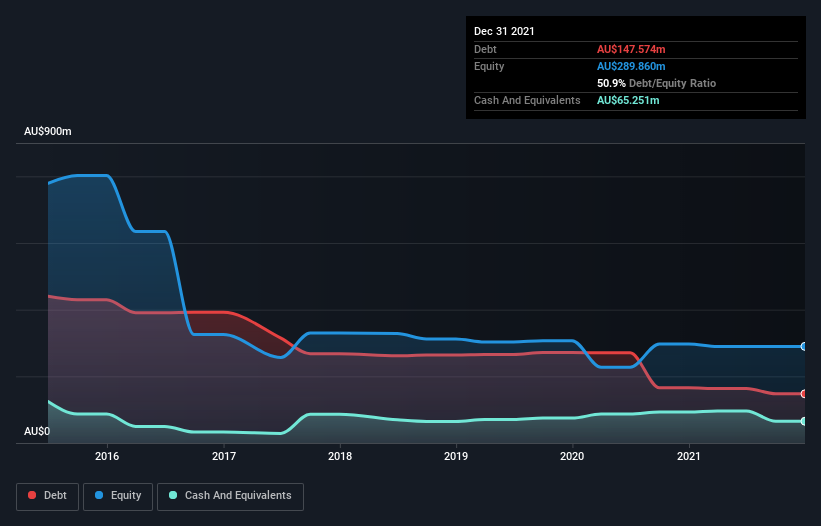
Legendary fund manager Li Lu (who Charlie Munger backed) once said, 'The biggest investment risk is not the volatility of prices, but whether you will suffer a permanent loss of capital.' When we think about how risky a company is, we always like to look at its use of debt, since debt overload can lead to ruin. As with many other companies MMA Offshore Limited (ASX:MRM) makes use of debt. But is this debt a concern to shareholders?
When Is Debt Dangerous?
Debt is a tool to help businesses grow, but if a business is incapable of paying off its lenders, then it exists at their mercy. Part and parcel of capitalism is the process of 'creative destruction' where failed businesses are mercilessly liquidated by their bankers. While that is not too common, we often do see indebted companies permanently diluting shareholders because lenders force them to raise capital at a distressed price. Of course, plenty of companies use debt to fund growth, without any negative consequences. The first thing to do when considering how much debt a business uses is to look at its cash and debt together.
Check out our latest analysis for MMA Offshore
How Much Debt Does MMA Offshore Carry?
As you can see below, MMA Offshore had AU$147.6m of debt at December 2021, down from AU$165.5m a year prior. However, it does have AU$65.3m in cash offsetting this, leading to net debt of about AU$82.3m.

A Look At MMA Offshore's Liabilities
We can see from the most recent balance sheet that MMA Offshore had liabilities of AU$80.2m falling due within a year, and liabilities of AU$148.4m due beyond that. On the other hand, it had cash of AU$65.3m and AU$70.0m worth of receivables due within a year. So its liabilities total AU$93.4m more than the combination of its cash and short-term receivables.
MMA Offshore has a market capitalization of AU$240.7m, so it could very likely raise cash to ameliorate its balance sheet, if the need arose. However, it is still worthwhile taking a close look at its ability to pay off debt. When analysing debt levels, the balance sheet is the obvious place to start. But ultimately the future profitability of the business will decide if MMA Offshore can strengthen its balance sheet over time. So if you want to see what the professionals think, you might find this free report on analyst profit forecasts to be interesting.
In the last year MMA Offshore had a loss before interest and tax, and actually shrunk its revenue by 2.7%, to AU$255m. That's not what we would hope to see.
Caveat Emptor
Importantly, MMA Offshore had an earnings before interest and tax (EBIT) loss over the last year. To be specific the EBIT loss came in at AU$11m. Considering that alongside the liabilities mentioned above does not give us much confidence that company should be using so much debt. Quite frankly we think the balance sheet is far from match-fit, although it could be improved with time. Another cause for caution is that is bled AU$8.7m in negative free cash flow over the last twelve months. So suffice it to say we do consider the stock to be risky. When analysing debt levels, the balance sheet is the obvious place to start. However, not all investment risk resides within the balance sheet - far from it. Case in point: We've spotted 1 warning sign for MMA Offshore you should be aware of.
At the end of the day, it's often better to focus on companies that are free from net debt. You can access our special list of such companies (all with a track record of profit growth). It's free.
New: Manage All Your Stock Portfolios in One Place
We've created the ultimate portfolio companion for stock investors, and it's free.
• Connect an unlimited number of Portfolios and see your total in one currency
• Be alerted to new Warning Signs or Risks via email or mobile
• Track the Fair Value of your stocks
Have feedback on this article? Concerned about the content? Get in touch with us directly. Alternatively, email editorial-team (at) simplywallst.com.
This article by Simply Wall St is general in nature. We provide commentary based on historical data and analyst forecasts only using an unbiased methodology and our articles are not intended to be financial advice. It does not constitute a recommendation to buy or sell any stock, and does not take account of your objectives, or your financial situation. We aim to bring you long-term focused analysis driven by fundamental data. Note that our analysis may not factor in the latest price-sensitive company announcements or qualitative material. Simply Wall St has no position in any stocks mentioned.
About ASX:MRM
MMA Offshore
Provides vessels, and marine and subsea services to the offshore energy, renewables, and wider maritime industries in Australia and internationally.
Flawless balance sheet and good value.
Similar Companies
Market Insights
Community Narratives



